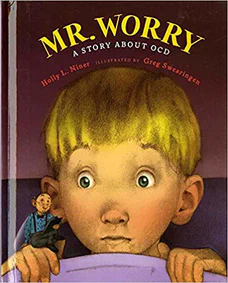Mr. Worry
A Story about OCD
Written by Holly L. Niner
Illustrated by Greg Swearingen
32 pages
•
Published 2003 (Albert Whitman & Company)

Recommended Age Range: 1st through 3rd grade, or perhaps even 4th grade.
Publisher's Summary:
Kevin can’t get to sleep at night until he does many things. He straightens his chair and the books on his desk. He asks his mother questions he already knows the answers to. He checks under his bed for a light he knows isn’t there, and then, a minute later, he checks again. Kevin knows these actions don’t make sense; he wants to stop, but the worry thoughts keep coming. When his parents realize that Kevin has too many worries, they take him to talk to a therapist. She tells Kevin and his parents that Kevin has a condition called obsessive-compulsive disorder (OCD) and that, more importantly, he can be helped.

Dr. Annie's Takeaways
Recommended for: This book is exclusively for a child who has recently been diagnosed with OCD and is starting treatment with a therapist who is trained in Exposure and Response Prevention (ERP)
. The book reassures children that they aren’t “crazy” or the only ones with OCD, and it teaches about ERP and the strategy of externalizing and talking back to OCD (the boy in this book calls his OCD thoughts “Mr. Worry”). It provides children with an analogy of medication being a child’s running shoes, the therapist being the coach, and the child being the runner (ERP is the “running strategy”). The book is a bit outdated but it’s still one of the best picture book introductions to ERP that I’ve been able to find.
Would a child like it? It’s not a particularly fun book, but it’s informative and could be reassuring to a child who has recently been diagnosed with OCD.
Evidence-Based Practices:
Psychoeducation, Exposure and Response Prevention (ERP), Cognitive Restructuring, Medication
Tone: Reassuring, matter-of-fact
Story Quality: The author, Holly Niner, shares in the forward of the book that her son was diagnosed with OCD, and the story has a lot of love and authenticity that reflect this. It’s an old book at this point, and it feels a bit old-fashioned with outdated references to cordless phones and home phones. Despite this, the book is a warm, hope-inducing story about a boy who is diagnosed with OCD. He goes to a therapist where he learns how to manage his OCD. There are some setbacks along the way, but he ultimately feels empowered to “hang up” on his OCD when it calls (there’s another metaphor about running introduced as well; this gets a smidge messy, from a story perspective). It’s informative, though, with enough heart that a child who relates to Kevin will be able to get through it.
Illustrations: The illustrations have a slightly eerie, soft sepia tone to them with muted colors. They almost look like they’re a combination of computer graphics and colored pencil, but I’m not sure. They’re inoffensive but not the most engaging.
Representation: Kevin is a White boy. He has a White mother and a White father. His therapist, Dr. Fraser is a White woman. Kevin’s teacher, Mr. Westby is a Black man. Kevin imagines his OCD as “Mr. Worry” who is pictured as a White man.
Psychological Practices: This story provides an overview of what treatment for OCD might look like once a child is diagnosed. It describes mechanisms of OCD, explains Exposure and Response Prevention (ERP)
, walks through successes and setbacks, and teaches a strategy of externalizing OCD and talking back to it. There is also an explanation of the benefits of medication and how this fits into a treatment plan (the analogy Dr. Fraser uses is that medication is like Kevin’s running shoes, she will be his coach, and he’ll be the runner). Kevin’s OCD includes a series of checking and reassurance seeking compulsions, as well as a nighttime ritual. He describes his mind as getting “sweaty” if he doesn’t do these things. He names his OCD “Mr. Worry,” and his therapist encourages him to “hang up” on Mr. Worry when he calls (in other words, not to listen to the urge to engage in a compulsion). Each week, Kevin works on resisting the urge to do one more step of his nighttime ritual until he no longer needs to do any of it. There are a couple of setbacks–once when Kevin tries to resist too many steps at once and is ultimately unable to resist any of them, and another time when Kevin has an uptick in OCD thoughts after watching a scary movie at a friend’s house. I appreciate these realistic examples and an acknowledgment that there will be ups and downs over time. The book ends with Kevin reducing the frequency of his therapy sessions and feeling empowered to “hang up” on OCD.
Concerns: None.
